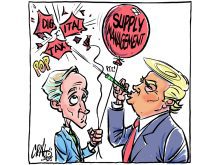THE MOOD at farm auction sales this spring is upbeat. The prices for used equipment seem to be tracking upward in sync with rising grain prices.
I experienced an altogether different mood at a recent international meeting where women leaders of the Via Campesina, a global peasant and family farmers’ movement, talked about rising grain prices.
Juana from the Dominican Republic told of food riots in neighbouring Haiti where desperate, hungry people were injured and killed. Elvira from the Philippines shared stories of families that can no longer afford enough food because the price of rice, the mainstay of their diets, has doubled.
Read Also

Agriculture needs to prepare for government spending cuts
As government makes necessary cuts to spending, what can be reduced or restructured in the budgets for agriculture?
For millions of people the food crisis is real and immediate.
The causes of this food crisis are complex. They include production problems due to climate change, population growth, more grain used as animal feed, rising oil prices making food production and transportation more expensive, financial speculation in commodity markets, and most recently, the diversion of food crops into agro-fuel production.
But while the causes of higher grain prices may not be transparent, the effects are obvious. Hundreds of millions of families have suddenly become vulnerable to the scourge of hunger.
How did so many get put into such a high risk position? Who set up a global system of gambling with the food supplies where picking up a high counter on grain prices for some players spells starvation for others?
For the past three decades there has been a persistent push to liberalize trade in agricultural goods. Looking at the patterns of this trade is more instructive than merely tracking prices in order to understand the crisis.
Trade agreements such as the North American Free Trade Agreement and the World Trade Organization forced the reorganization of food production everywhere, including Canada.
Staple food production, particularly grains that are more suited to mass, mono-cultural, high input production, moved to industrialized countries.
At the same time, many developing countries were pressured to eliminate subsistence peasant agriculture in favour of higher-value luxury crops such as pineapples, coffee, cocoa and cut flowers. High interest debts demanded cash crops for repayment.
These trade and financial arrangements have deliberately created a system where developing countries are dependent on cheap, often subsidized imported grains to meet basic food needs.
For example, Mexico moved from being self-sufficient in corn to its current position of importing 40 percent of it from the United States. The Philippines, once an exporter of rice, has become the largest single importer of its staple food.
So rising grain prices have an immediate, shrinking effect on the amount of rice in the Filipino’s bowl or the tortillas on the Mexican family’s table.
On the other hand, even if the price of coffee or cut flowers rose steeply, which they haven’t, would it really threaten our families?
The current agriculture trade system increases the vulnerability of millions of people. The political, corporate and financial bodies that negotiated and instituted these agreements must accept responsibility for this unacceptable risk to human lives and make amends.
Nettie Wiebe is a farmer in the Delisle, Sask., region and a professor of Church and Society at St. Andrews College in Saskatoon. She is also the federal NDP candidate for Saskatoon-Rosetown-Biggar.
















